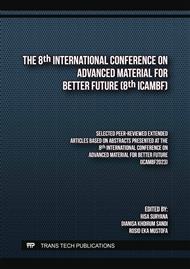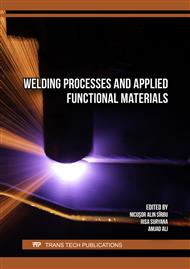[1]
M. Schadt and W. Helfrich, Voltage-dependent optical activity of a twisted nematic liquid crystal, Appl. Phys. Lett., 18 (1971)127-128.
DOI: 10.1063/1.1653593
Google Scholar
[2]
A. Buka, N. Éber, W. Pesch, L. Kramer, Convective patterns in liquid crystals driven by electric field, in: A.A. Golovin, A.A. Nepomnyashchy (Eds.), Advances in sensing with security applications. NATO Science Series II: Mathematics, Physics and Chemistry, vol 218, Springer, Dordrecht, 2006, pp.55-82.
DOI: 10.1007/1-4020-4355-4_02
Google Scholar
[3]
E.F. Carr, Influence of electric fields on the molecular alignment in the liquid crystal p-(anisalamino)-phenyl Acetate, Mol. Cryst., 7 (1969) 253-268.
DOI: 10.1080/15421406908084876
Google Scholar
[4]
W. Helfrich, Conduction‐induced alignment of nematic liquid crystals: Basic model and stability considerations, J. Chem. Phys., 51 (1969) 4092-4105.
DOI: 10.1063/1.1672632
Google Scholar
[5]
S. Kai, K. Yamaguchi. and K. Hirakawa, Observation of flow figures in nematic liquid crystal MBBA, Jpn. J. Appl. Phys., 14 (1975) 1653-16.
DOI: 10.1143/jjap.14.1653
Google Scholar
[6]
J.-H. Huh and S. Kai, Electroconvection in nematic liquid crystals in Hele-Shaw cells, Phys. Rev. E, 68 (2003) 042702-1-4
DOI: 10.1103/physreve.68.042702
Google Scholar
[7]
E. M. Kusumasari, A.J. Suharli, B. Mahendra, and Yusril Yusuf, Flows in parallelepiped cells of nematic liquid crystals, Phys. Rev. E, 106 (2022) 064702-1-6
DOI: 10.1103/physreve.106.064702
Google Scholar
[8]
P.C. Wu, S.Y. Yang, and W. Lee, Recovery of UV-degraded electrical properties of nematic liquid crystals doped with TiO2 nanoparticles, J. Mol. Liq., 218 (2016) 150-156.
DOI: 10.1016/j.molliq.2016.02.029
Google Scholar
[9]
Y. Zhan, H. Lu, M. Jin and G. Zhou, Electrohydrodynamic instabilities for smart window applications, Liq. Cryst., 47 (2020) 977-983.
DOI: 10.1080/02678292.2019.1692929
Google Scholar
[10]
V.S. Sutormin, M.N. Krakhalev, O.O. Prishchepa, W. Lee and V.Y. Zyryanov, Electro-optical response of an ionic-surfactant-doped nematic cell with homeoplanar–twisted configuration transition, Opt. Mater. Express, 4 (2014) 810-815.
DOI: 10.1364/ome.4.000810
Google Scholar
[11]
H. Shaban, P.C. Wu, J.H. Lee, and W. Lee, Dielectric and electro-optical responses of a dielectrically negative nematic liquid crystal doped with cationic surfactant, Opt. Mater. Express, 11 (2021) 3208-3222.
DOI: 10.1364/ome.437701
Google Scholar
[12]
O.V. Kovalchuk, T.M. Kovalchuk, N. Tomašovičová, M. Timko, K. Zakutanska, D. Miakota, P. Kopčanský, O.F. Shevchuk, and Y. Garbovskiy, Dielectric and electrical properties of nematic liquid crystals 6CB doped with iron oxide nanoparticles. The combined effect of nanodopant concentration and cell thickness, J. Mol. Liq., 366 (2022) 120305-1-9.
DOI: 10.1016/j.molliq.2022.120305
Google Scholar
[13]
Anu, D. Varshney, K. Yadav, J. Prakash, H. Meena, G. Singh, Tunable dielectric and memory features of ferroelectric layered perovskite Bi4Ti3O12 nanoparticles doped nematic liquid crystal composite, J. Mol. Liq., 369 (2023) 120820-1-14.
DOI: 10.1016/j.molliq.2022.120820
Google Scholar
[14]
A. Rani, S. Chakraborty, A. Sinha, Effect of CdSe/ZnS quantum dots doping on the ion transport behavior in nematic liquid crystal, J. Mol. Liq., 342 (2021) 117327-1-13.
DOI: 10.1016/j.molliq.2021.117327
Google Scholar
[15]
Y. Takikawa1, K. Kaneko, S. Odani, T. Ikemura, and M. Iwata, Dielectric anisotropy in PCPB/MBBA mixtures showing the dual frequency characteristic, Jpn. J. Appl. Phys., 59 (2020) SDDB05-1-6.
DOI: 10.7567/1347-4065/ab4ece
Google Scholar
[16]
K.S. Cole and R.H. Cole, Dispersion and absorption in dielectrics I. Alternating current characteristics, J. Chem. Phys., 9 (1941) 341-351.
DOI: 10.1063/1.1750906
Google Scholar
[17]
L.N. Bugaeva, A.M. Gabovich, P.P. Korniychuk, Y.A. Reznikov, K. Singer, and A.I. Voitenko, DC current in 4-N-Pentyl-4'-Cyanobiphenyl liquid crystal cells, Mol. Cryst. Liq. Cryst., 540 (2011) 182-187.
DOI: 10.1080/15421406.2011.568839
Google Scholar
[18]
P.P. Korniychuka, A.M. Gabovich, K. Singer, A.I. Voitenko, and Y.A. Reznikov, Transient and steady electric currents through a liquid crystal cell, Liq. Cryst., 37 (2010) 1171-1181.
DOI: 10.1080/02678292.2010.490622
Google Scholar
[19]
H. Mada and H. Yamada, Measurement of Steady-State Current Flowing in Nematic Liquid Crystal, Jpn. J. Appl. Phys., 33 (1994) 5886-5887
DOI: 10.1143/jjap.33.5886
Google Scholar



